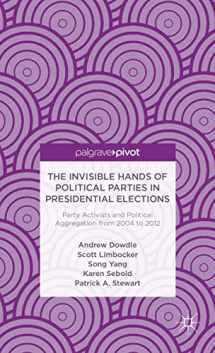
The Invisible Hands of Political Parties in Presidential Elections: Party Activists and Political Aggregation from 2004 to 2012 (Palgrave Pivot)
ISBN-13:
9781137322791
ISBN-10:
1137322799
Edition:
2013
Author:
P. Stewart, A. Dowdle, S. Limbocker, S. Yang, K. Sebold
Publication date:
2013
Publisher:
Palgrave Pivot
Format:
Hardcover
155 pages
FREE US shipping
on ALL non-marketplace orders
Marketplace
from $2.00
USD
Marketplace offers
Seller
Condition
Note
Seller
Condition
Used - Very Good
Cover has some dirty. Good reading copy. Pages are clean, text intact and unmarred.
Book details
ISBN-13:
9781137322791
ISBN-10:
1137322799
Edition:
2013
Author:
P. Stewart, A. Dowdle, S. Limbocker, S. Yang, K. Sebold
Publication date:
2013
Publisher:
Palgrave Pivot
Format:
Hardcover
155 pages
Summary
The Invisible Hands of Political Parties in Presidential Elections: Party Activists and Political Aggregation from 2004 to 2012 (Palgrave Pivot) (ISBN-13: 9781137322791 and ISBN-10: 1137322799), written by authors
P. Stewart, A. Dowdle, S. Limbocker, S. Yang, K. Sebold, was published by Palgrave Pivot in 2013.
With an overall rating of 4.1 stars, it's a notable title among other
books. You can easily purchase or rent The Invisible Hands of Political Parties in Presidential Elections: Party Activists and Political Aggregation from 2004 to 2012 (Palgrave Pivot) (Hardcover) from BooksRun,
along with many other new and used
books
and textbooks.
And, if you're looking to sell your copy, our current buyback offer is $0.3.
Description
One of the truisms in American politics has been that "divisive" primaries hurt the party's prospects of winning the presidency in the general election. However, traditional definitions of divisive primaries focus too much on candidate behavior and not enough on the actual divisions and fractures within a party. The Invisible Hands of Political Parties in Presidential Elections proposes a new measure of party cohesion that instead looks at individual donors who are willing to contribute to multiple candidates during the early stages of the presidential primaries. The authors of this collection reveal how these preprimary donor networks can serve as an accurate barometer of party unity, providing a significant perspective on the changing roles of political parties in American government today.


We would LOVE it if you could help us and other readers by reviewing the book
Book review

Congratulations! We have received your book review.
{user}
{createdAt}
by {truncated_author}


